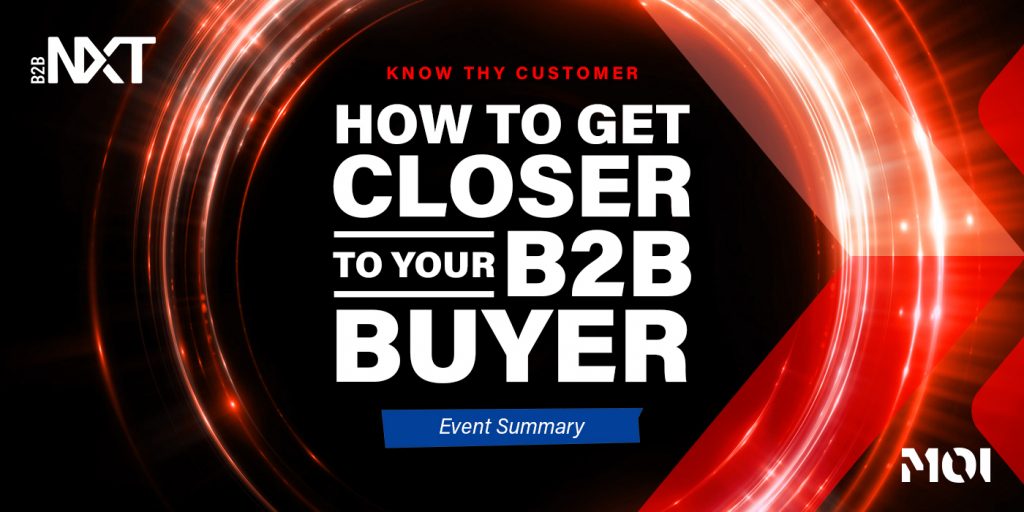6 min read

Over the past couple of years, ‘empathy’ is a subject that has come up many times at B2BNXT. So, it was bound to feature at an event called Know Thy Customer – Understanding Who Your Buyer Is. The event — our first virtual B2BNXT — explored how, by delivering great customer experiences, marketers can get closer to their buyers.
I had the pleasure of hosting a conversation between two heavyweight empaths; Ian Golding, a world-renowned customer experience (CX) specialist, and Nick Hague, co-founder of research firm B2B International.
Though CX is always important under normal circumstances, it’s especially so right now, as businesses begin the big return to work and try to adapt to what everyone is calling ‘the new normal’.
Why marketers shouldn’t shut up about CX
According to research from Nick and his colleagues at B2B International, 52% of B2B brands say that delivering excellent customer experiences is one of their biggest challenges. While it’s good to see that the message on the importance of CX is getting through, only 15% of B2B brands are currently at the level of ‘CX leader’. There’s clearly a lot of work to do.

Empathy pays off
We heard from our B2BNXT speakers that empathy is the most significant principle behind CX and customer engagement. But a lot of business leaders fail to see the connection between empathy with buyers and their organisation’s financial performance. Yet study after study has revealed a direct link.
The more you show empathy to customers, the more likely you are to convert them into advocates, making them more loyal. Those loyal customers are more likely to come back and spend more money… and there’s your growth.

That’s also why we need to tread carefully when it comes to replacing human interaction with digital technology. Even if it’s designed to make things easier for customers, you might end up sacrificing the real reason they come to you.
It’s a long haul, but worth making a start
When it comes to the benefits of delivering great customer experiences, there is a bit of bad news here: Ian has found that it can take CX laggards 6-8 years to transform their CX for long-term financial return. And many businesses just don’t have the ability to do it.
On the flip side, however, eliminating the causes of random poor experiences can still help you reduce or avoid costs. So, improving your CX is usually worth it, even if it won’t give you immediate growth.
What does good CX look like?
Before we can talk about how to create excellent customer experiences, we need to define what it is.
Ian showed us how any experience can be broken down into three parts:
The first – and historically the one most businesses use to differentiate themselves – is the functional component of your product or service, i.e. what does the thing you’re selling actually do? The problem with relying on function for differentiation is that it’s now increasingly difficult, if not impossible, to do so.
Then there’s the accessibility factor. It’s becoming more and more important that your products and services are easy to use.
The final part is emotional. It’s the most important factor because it’s the one that customers are most likely to remember. As Ian says, people tend to remember very good experiences, very bad experiences, or nothing at all. That last one is by far the worst of the three because it means a customer hasn’t responded emotionally to your brand.
What the 15% do – how to be a CX leader
The best way to learn how you can transform your customer experience is to see what the CX leaders do differently.
Minimise randomness
Even the worst business in the world will occasionally deliver a great customer experience, even if by accident. But relying on accidents isn’t exactly efficient or effective. That’s why 15% of B2B brands that are CX leaders work on minimising randomness, with a structured approach that makes management of their customer experience intentional.
Share a vision
“CX is a science, but it’s not an exact science,” says Ian. “Every organisation is different so there’s no CX textbook.” You need to define and understand what customer experience looks like for your organisation.
How do you want your customer to feel when they interact with you? Many organisations don’t really know, letting it happen by chance.
You also need to break down siloes that exist between functions and get everybody working together towards a shared vision for the entire organisation.
Whoever is handed responsibility for CX – and it doesn’t matter where they sit in the organisation – they’re just the flag-bearer. Everyone is responsible for delivering great experiences.
Be consistent
According to Nick’s research, 30% of B2B brands are CX laggards. Of those, 54% “struggle to drive consistency across various platforms, agencies, and tools”. And 68% struggle with consistency across the entire customer lifecycle.
CX leaders, on the other hand, tend to go deeper, looking to deliver consistency across all the platforms they use, whether that’s digital or face-to-face.
Know thy customer
And now we come full circle, back to the topic of the evening’s conversation. To deliver great customer experiences, you need to understand who your buyer is.

Almost half (49%) of CX laggards “struggle connecting with customers on an emotional level to drive higher brand engagement.” As we’ve already learned, this is crucial. But the laggards can’t reach their customers on an emotional level because they also lack an understanding of their needs, attitudes, and behaviours.
CX leaders know their customers well – they’re talking to them more, they’re learning from data, and they’re better able to place their customers at the heart of everything they do. It means considering customers when developing specific products or even aligning them to specific customer demographics.
But how do you know who your customers are? Nick admits that he’s biased here, being a co-founder of a research company, but research is going to be your best bet.
However, if full-on market research isn’t practical or affordable for your business, learning about your customer can be as simple as talking to people in your organisation. Salespeople spend a lot of time with customers, so they should have a pretty good idea of the customer’s pain points and their ever-changing needs. These are vital insights to feedback into the rest of the business and inform your product development and customer service.
How COVID-19 is changing the customer experience
Although ‘customer experience and loyalty’ remains marketers’ top priority, it’s worrying to see that ‘raising awareness/top of funnel’ has dropped from fourth place to 17th — compared to 2019.

“We’ve seen, from previous recessions,” says Nick, “that cutting investment in brand building during tough times, weakens growth opportunities in the medium-to-long-term.”
It’s not all bad news though. Nick shared how a client of his has seen their NPS scores “shoot through the roof” in the last few months. They’ve not had a single face-to-face sales visit, yet their sales teams have been busy at their desks, doing video calls and answering emails.
Though Nick has seen a reluctance in some businesses to move to a fully remote or virtual model, the last few months have shown us that we don’t need to be stuck in the past in terms of how we meet our customers’ requirements.
There’s also a growing movement among B2B brands to take direct routes to market, rather than going through resellers. This is another way we can get closer to our customers.
Another trend that Nick has noticed is a rise in ‘green positioning’ and purpose-driven marketing. In anticipation of how the new normal may look, organisations are gambling on buyers being more socially conscientious in the future. It’s a very customer-centric approach, which is only going to become more important.
See you at the next B2BNXT
I’d like to say a huge thank you to my guest speakers, Ian Golding and Nick Hague, for helping to make our first virtual B2BNXT such an incredibly insightful success.
Customer experience is quickly becoming the biggest differentiator for both B2B and B2C brands, so it’s something every marketer needs to become skilled in. I hope the advice from Ian and Nick will help you and your brand to deliver consistently great experiences.
You can watch an on-demand recording of B2BNXT: Know Thy Customer here.
Stay tuned for news of the next B2BNXT virtual event: Buyer Enablement — Bridging The Sales & Marketing Divide — taking place in October. I’ll let you know more as soon as we have the details.
Related content









